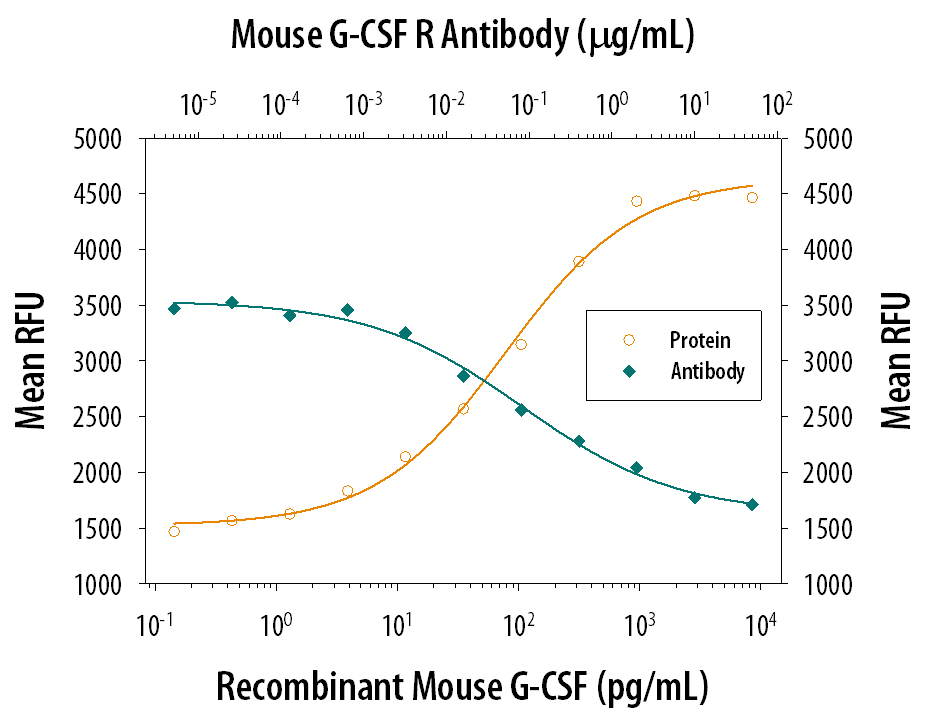Mouse G-CSFR/CD114 Antibody Summary
Cys26-Asp626
Accession # P40223
Applications
Please Note: Optimal dilutions should be determined by each laboratory for each application. General Protocols are available in the Technical Information section on our website.
Scientific Data
 View Larger
View Larger
Cell Proliferation Induced by G‑CSF and Neutralization by Mouse G‑CSF R/CD114 Antibody. Recombinant Mouse G-CSF (Catalog # 414-CS) stimulates proliferation in the NFS-60 mouse myeloid cell line in a dose-dependent manner (orange line). Proliferation elicited by Recombinant Mouse G-CSF (0.15 ng/mL) is neutralized (green line) by increasing concentrations of Rat Anti-Mouse G-CSF R/CD114 Monoclonal Antibody (Catalog # MAB6039). The ND50 is typically 0.015-0.075 µg/mL.
Reconstitution Calculator
Preparation and Storage
- 12 months from date of receipt, -20 to -70 °C as supplied.
- 1 month, 2 to 8 °C under sterile conditions after reconstitution.
- 6 months, -20 to -70 °C under sterile conditions after reconstitution.
Background: G-CSFR/CD114
Granulocyte colony stimulating factor (G-CSF) is a pleiotropic cytokine best known for its specific effects on the proliferation, differentiation, and activation of hematopoietic cells of the neutrophilic and granulocyte lineage (1). G-CSF plays an important role in defense against infection, in inflammation and repair, and in the maintenance of steady state hematopoiesis. Cell activation by G‑CSF is mediated by granulocyte colony stimulating factor receptor alpha (G-CSF R; also CD114), a 95‑105 kDa type I transmembrane protein and member of the cytokine receptor superfamily, type I cytokine receptor family, and type 2 subfamily of receptor proteins. Mouse G‑CSF R is synthesized as an 837 amino acid (aa) precursor that contains a 25 aa signal sequence, a 601 aa extracellular domain (ECD), a 24 aa transmembrane region, and a 187 aa cytoplasmic tail. The ECD contains one Ig-like C2-type domain, five fibronectin type-III domains, and 11 potential sites for N‑linked glycosylation. Within the ECD there is also a WSXWS motif (aa 319‑323) that is necessary for proper protein folding and thereby efficient intracellular transport and cell-surface receptor binding (2). Also, within the cytoplasmic domain there is a Box 1 motif which is required for JAK interaction and/or activation (1). Mouse G‑CSF R shares 63% aa sequence identity with human G‑CSF R. G-CSF R is expressed in mature neutrophils, neutrophilic precursors, myeloid leukemia cells, and placenta (1). Mutations have been found in the gene encoding G-CSF R in some patients with severe congenital neutropenia (1). These mutations typically lead to a truncation in the cytoplasmic domain of the G-CSF R leading to maturation arrest of neutrophilic precursors in the bone marrow and neutropenia in peripheral blood (3). Binding of G-CSF to its receptor induces dimerization or oligomerization of the receptor activating cytoplasmic tyrosine kinases (2). Signal transduction from pathways that involve Janus tyrosine kinases/signal transducer and activator of transcription proteins (Jak1, Jak2, and Tyk2/STAT3 and STATG), src-related protein tyrosine kinases (Lyn and Syk), Ras/MAP kinase, and phosphatidylinositol have been reported to be activated upon G-CSF stimulation (4).
- Ward, A.C. (2007) Front. Biosci. 12:608.
- Layton, J.E. and N.E. Hall (2006) Front. Biosci. 11:3181.
- Mitsui, T. et al. (2003) Blood 101:2990.
- Nicola, N.A. in Cytokine Reference, 2001, Oppenheim, J.J. and M. Feldmann, eds. Academic Press p.1935.
Product Datasheets
Citations for Mouse G-CSFR/CD114 Antibody
R&D Systems personnel manually curate a database that contains references using R&D Systems products. The data collected includes not only links to publications in PubMed, but also provides information about sample types, species, and experimental conditions.
2
Citations: Showing 1 - 2
Filter your results:
Filter by:
-
Granulocyte Colony-Stimulating Factor Does Not Influence Clostridium Perfringens α-Toxin-Induced Myonecrosis in Mice
Authors: M Takehara, Y Sonobe, H Bandou, K Kobayashi, M Nagahama
Toxins (Basel), 2019-08-30;11(9):.
Species: Mouse
Sample Types: In Vivo
Applications: Neutralization -
LECT2 drives haematopoietic stem cell expansion and mobilization via regulating the macrophages and osteolineage cells
Nat Commun, 2016-09-06;7(0):12719.
Species: Mouse
Sample Types: In Vivo
Applications: Neutralization
FAQs
No product specific FAQs exist for this product, however you may
View all Antibody FAQsReviews for Mouse G-CSFR/CD114 Antibody
There are currently no reviews for this product. Be the first to review Mouse G-CSFR/CD114 Antibody and earn rewards!
Have you used Mouse G-CSFR/CD114 Antibody?
Submit a review and receive an Amazon gift card.
$25/€18/£15/$25CAN/¥75 Yuan/¥2500 Yen for a review with an image
$10/€7/£6/$10 CAD/¥70 Yuan/¥1110 Yen for a review without an image


